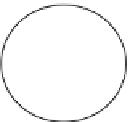Hardware Reference
In-Depth Information
Tabl e 3. 4
Resource report for synthesized modules
# Logic
# Combinational
# Logic
#Total
#Total
elements
functions
registers
registers
pins
Image-based droplet tracking
4,631
4,627
230
230
22
De-compaction (Method I)
249
249
144
14
42
De-compaction (Method II)
42
42
31
31
42
Tabl e 3. 5
Resource report for synthesized FSMs with different number of states
No. state of
the FSM
# Logic
elements
# Combinational
functions
# Logic
registers
#Total
registers
#Total
pins
50
62
35
50
50
13
500
390
390
9
9
13
800
680
680
10
10
18
1,200
419
419
11
11
18
1,600
168
168
11
11
35
Fig. 3.6
Splitting of a
droplet: both Electrodes
1
and
3
are actuated, and
electrowetting forces are
generated on the surfaces of
these two electrodes
The 2x droplet to be split
1
3
2
2
Actuated electrodes
3.7
Fault Simulation in the Presence of Chip-Parameter
Va r i a t i o n s
In this section, we examine the nature of the errors that occur in splitting operations
and present a parameter variation-aware fault simulation algorithm. By considering
the variations in the parameters of the biochip electrodes, the simulator can mimic
the erroneous behavior during the execution of bioassay.
As introduced in Sect.
3.1
, error occurrence in the biochip is defined as the
occurrences of droplets with abnormal volumes or concentrations. Experimental
results with fabricated biochips show that the generation of abnormal droplets in
asymmetric splitting operations is the primary cause of errors that occur in biochips
[
24
]. Furthermore, as introduced in Sect.
3.2.1
, splitting operations are frequently
implemented in bioassays. Therefore, most of the errors that occur during the
execution of the bioassay are caused by the asymmetric splitting operations [
31
].
As shown in Fig.
3.6
, to split the droplet on Electrode 2, Electrode 1 and Electrode
3 are actuated at the same time. Two electrowetting forces, represented as F
1
and
F
3
, are generated on the surfaces of Electrodes 1 and 3, respectively. The droplet on
Electrode 2 will be split under F
1
and F
3
, which are applied in opposite directions.
The electrowetting force applied on a droplet can be written as [
32
]:












































































